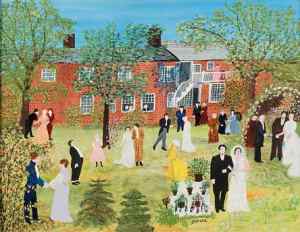Grandma Moses–Artist
 She did not begin painting until she was 77, and then only because arthritis made needlework too uncomfortable. Her family never quite took her seriously as an artist, nor understood why her stick fingers and colors were prized by collectors around the world. Upon her death, a German collector explained the appeal of her paintings:
She did not begin painting until she was 77, and then only because arthritis made needlework too uncomfortable. Her family never quite took her seriously as an artist, nor understood why her stick fingers and colors were prized by collectors around the world. Upon her death, a German collector explained the appeal of her paintings:
“There emanates from her paintings a light-hearted optimism; the world she shows us is beautiful and it is good. You feel at home in all these pictures, and you know their meaning. The unrest and the neurotic insecurity of the present day make us inclined to enjoy the simple and affirmative outlook of Grandma Moses.”
Today, Grandma Moses is remembered as the foremost American primitive painter of the 20th century.
Anna Mary Robertson was born in Greenwich, New York in 1860. At age 27, she married Thomas Salmon Moses. Returning from their wedding trip to North Carolina, they bought land in Virginia and remained there for twenty years. They had ten children, five of whom died in infancy. They returned to New York with their five surviving children and settled in Eagle Bridge, where Thomas Moses died in 1927. Anna continued to run the farm, but had to stop both farm chores and embroidery when she developed arthritis in her hands.
She began painting on old pieces of boards painted white, thinking she was painting only for herself, or perhaps her family. Two years later, she took some of her paintings to the Women’s Exchange, hoping to barter them. Collector Louis J. Caldor spotted her paintings displayed in the local drug store; he bought as many as he could from the drugstore, then drove to Moses’ home in Eagle Ridge, New York, to but more. He exhibited them at the Museum of Modern Art in New York City in 1939. In 1940, Moses had her own one-woman show, a critical and commercial success.
Although she never received formal art education, she was awarded honorary doctoral degrees from Russell Sage College and the Moore Institute of Art, Science and Industry. She was honored by Governor Rockefeller, who named her 100th and 101st birthdays statewide Grandma Moses Days. She was honored by President Truman in 1949 and appeared on Edward R. Murrow’s “See it Now” in 1955(3). She continued painting until her death in 1961, producing nearly 1500 paintings.
Sources:
1: Lunardini, Christine. “1939: Grandma Moses’ Paintings are Exhibited at the Museum of Modern Art” in What Every American Should Know About Women’s History. Pp. 256-257. Avon, Massachusetts: Adams Media Corporation, 1997.
2: “Grandma Moses is dead at 101; primitive artist ‘just wore out.’ ” The New York Times. 12/14/1961.
3: “Grandma Moses in the 21st Century.” 2001.
1: Lunardini, Christine. “1939: Grandma Moses’ Paintings are Exhibited at the Museum of Modern Art” in What Every American Should Know About Women’s History. Pp. 256-257. Avon, Massachusetts: Adams Media Corporation, 1997.
2: “Grandma Moses is dead at 101; primitive artist ‘just wore out.’ ” The New York Times. 12/14/1961.
3: “Grandma Moses in the 21st Century.” 2001.
To learn more:
The Bennington Museum in Bennington, Vermont, owns the largest public collection of Grandma Moses’ art.
Kallir, Jane, et. al. Grandma Moses in the 21st Century. New Haven, CT: Yale University Press, 2001.
Marling, Karal Ann. Designs on the Heart: The Homemade Art of Grandma Moses. Cambridge, MA: Harvard University Press, 2006.
The Bennington Museum in Bennington, Vermont, owns the largest public collection of Grandma Moses’ art.
Kallir, Jane, et. al. Grandma Moses in the 21st Century. New Haven, CT: Yale University Press, 2001.
Marling, Karal Ann. Designs on the Heart: The Homemade Art of Grandma Moses. Cambridge, MA: Harvard University Press, 2006.

No comments:
Post a Comment